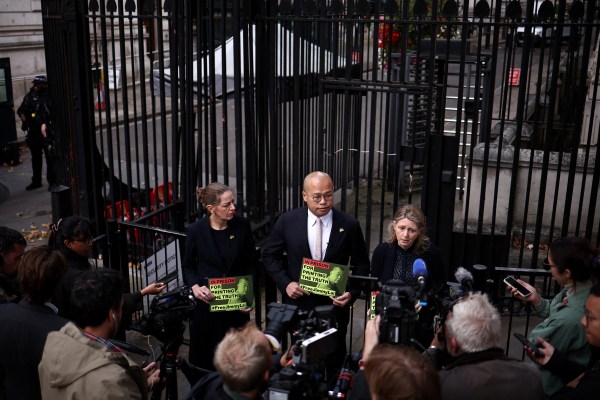House Republicans have long promised to provide public access to the security footage from the January 6 Capitol riot, and on November 17, 2023, Speaker Mike Johnson announced that more than 40,000 hours of video would both be posted online and made available at the Subcommittee on Oversight’s offices in Washington, D.C. Approximately 95 percent of the 44,000 total hours recorded are being released, excluding footage that could result in retaliation against private citizens or compromise “sensitive” security information. The uploads follow the release of more than 41,000 hours of video to then-Fox News host Tucker Carlson by House Speaker Kevin McCarthy in March. It is unclear if any footage given to Carlson will be excluded from the broader public release.
Carlson’s coverage of the footage fed theories that rioters had been unfairly persecuted by the Department of Justice and that trespassers in the Capitol were largely peaceful tourists. “They were peaceful, they were orderly and meek. These were not insurrectionists. They were sightseers,” Carlson said. “Footage from inside the Capitol overturns the story you have heard about January 6.”
Since Johnson’s release of the footage to the public, right-wing outlets and influencers have put forward similar clips purporting to show that police stood by idly as peaceful rallygoers toured the Capitol building. Biotech entrepreneur Vivek Ramaswamy even echoed such claims during a Republican presidential primary debate in early December, asking, “Why am I the only person on the stage at least who can say that January 6 now does look like it was an inside job?”
X user Behizy, who has 108,000 followers on the platform, made a similar point in a sarcastic tweet that shows dozens of protesters walking through a hallway as police watch on.
A November 17 story in Gateway Pundit sums up these assertions: “UPDATE: House Speaker Mike Johnson OFFICIALLY Releases First Batch of January 6 Surveillance Camera Footage – And Guess What?… No Insurrection! No Riot!”
These claims rely on select footage suggesting that the protests were largely peaceful, ignoring substantial video evidence depicting high levels of violence, chaos, and illegal activity. Since January 6, 2021, more than 1,230 individuals have been charged in relation to the attack on the Capitol, of whom more than 440 have been charged with assaulting or impeding law enforcement officers—a felony offense. According to the Department of Justice, approximately 140 police officers were assaulted on January 6.
Many defendants have admitted to and been sentenced for violent activity, such as Justin Dee Adams who pleaded guilty in August 2023 to charges related to rushing a police line, striking a police officer multiple times, and throwing bottles at law enforcement. Henry Tarrio, Ethan Nordean, Joseph Biggs, Zachary Rehl, and Dominic Pezzola—five leaders of the militia organization Proud Boys—were handed particularly heavy sentences for acts of violence and conspiracy, receiving 22, 18, 17, 15, and 10 years respectively. Violent actors continue to be identified and arrested nearly three years on from the riot, including a North Carolina couple arrested on December 11 for “shoving and punching law enforcement officers,” and participating in an effort to seize an officer’s baton. Last week, Dana Bell—a 65-year-old Texas woman—was similarly arrested and charged for assaulting multiple members of the media and grabbing an officer's baton.
When viewed out of context, it is understandable how footage of police standing passively as rioters wander the Capitol lends itself to widespread “false flag” theorizing. However, proper knowledge of Capitol Police history, procedures, and training discredits claims of police complicity. “I think the way they’re being released without giving in any understanding of what’s going on is unfair,” Terrance Gainer, a former law enforcement officer who served as chief of the Capitol Police from 2002 to 2006 and sergeant at arms of the Senate from 2006 to 2014, told The Dispatch Fact Check. “If you’re not well versed in what tactics should be utilized, what use of force is supposed to be employed, what your expectations are for that, or what your own biases are, I don’t think you can draw a good conclusion.”
The reaction of the police is better attributed to a lack of scenario-specific training, the implementation of de-escalatory tactics, and widespread confusion among officers.
“I don’t think there was anything but everybody trying to do the best under the circumstances they had, and that did mean in some circumstances that you had to be a bystander to some of the large crowds,” Gainer remarked. “They weren’t facilitating the people who were in the building; I don’t think they were in a position to change the course of what was going on in many different circumstances.”
Gainer—who also unsuccessfully ran as a Republican for state attorney of Cook County in Illinois’ 1988 elections—joined the Capitol Police following the September 11 attacks, when Congress wanted to rebuild the department to better counter potential terrorist threats. “Officers were well armed to repel what we thought would be state-sponsored terrorism,” Gainer said. “But, we did not practice fighting large crowds inside the Capitol, because it wasn’t part of how we envisioned things would unfold. Even as we kept trying to develop better defensive mechanisms—the type of doors, the type of windows, the type of alarms, heavier weapons—we still never anticipated that people could breach and get into the Capitol in large numbers. We did not actively train officers on what to do if you’re in a hallway and 500 people are rushing at you.”
As such, many were left to rely on other training and their own instincts when rioters breached the building. “Officers were left in large part to the routine training they were given on crowd control, which didn’t fit the scenario for inside the building,” Gainer explained.
The result was a breakdown of communication and coordination. “The best of systems got overwhelmed even while the Capitol, Metropolitan Police, and Federal units responded,” Gainer said. “It just became a battle for survival for officers on both the West Front and the East Front of the Capitol.”
According to Gainer, the U.S. Capitol Police, Metropolitan Police, Park Police, and Secret Service are all well-trained in crowd control procedures because of the frequency of large rallies and protests in the Washington, D.C., area. However, these events are generally well-coordinated with police in advance. When large events receive permits, police typically work actively with organizers to determine how many people may be present, whether individuals may try to be arrested, and what the goal of the event is. There is consistent communication between police and civilian leaders, and police are prepared to address small pockets of individuals engaging in illegal or dangerous activities without disrupting the larger event. However, despite the Capitol police issuing permits for six demonstrations on January 6, the typical communication between event organizers and police was not present as the Capitol came under attack.
The Capitol Police also adhere to a formal incident management system designed through the federal government and taught through a series of courses by the Federal Emergency Management Agency. According to Gainer, a mass event like the “Stop the Steal” rally would require a number of joint operational command centers where organizations including the Metropolitan Police, Capitol Police, Park Police, Secret Service, and Metro Transit Police can communicate, share intelligence, and coordinate law enforcement activities.
“The bottom line for me is those officers did the best they could under the circumstances and there were an awful lot of lessons learned for all of us,” Gainer added. “Those officers fought valiantly to try to restore order, even if they did that through peaceful deescalation.”
In short, the released videos have been promoted selectively to leave out actual violence on January 6. The behavior seen by police doesn’t support claims of a false-flag operation, but instead reflects a lack of preparation, breakdown of communication, and the use of de-escalatory tactics. Claims that the videos show only peaceful protests or that there was no riot are false.
If you have a claim you would like to see us fact check, please send us an email at factcheck@thedispatch.com. If you would like to suggest a correction to this piece or any other Dispatch article, please email corrections@thedispatch.com.







Please note that we at The Dispatch hold ourselves, our work, and our commenters to a higher standard than other places on the internet. We welcome comments that foster genuine debate or discussion—including comments critical of us or our work—but responses that include ad hominem attacks on fellow Dispatch members or are intended to stoke fear and anger may be moderated.
With your membership, you only have the ability to comment on The Morning Dispatch articles. Consider upgrading to join the conversation everywhere.